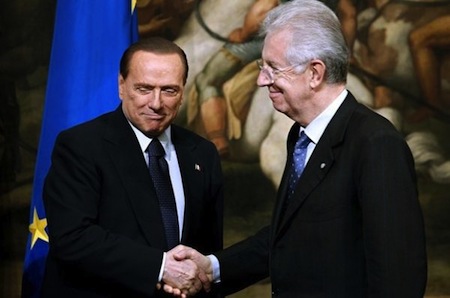There are now less than two weeks to go before Italians select a new prime minister, and if you watched the dueling soundbites, you would be forgiven if you thought the two main contenders were current prime minister Mario Monti and former prime minister Silvio Berlusconi.![]()
But while Berlusconi and Monti have taken up much of the headlines, the centrosinistra (center-left) coalition headed by Pier Luigi Bersani, the leader of Italy’s center-left Partito Democratico (PD, Democratic Party), still seems more likely than not to win the Feb. 24 and 25 parliamentary elections, guaranteeing a majority in the 630-member Camera dei Deputati (House of Deputies), the lower house of the Parlamento Italiano (Italian Parliament) and a plurality of the seats among the 315 elected members of its upper house, the Senato (Senate).
As of last Friday — the last day under Italian law that new polls can be published in advance of the election — the broad centrosinistra coalition still held a single-digit, but steady, lead over the centrodestra coalition dominated by Berlusconi’s Popolo della Libertà (PdL, People of Freedom). After consolidating the center-right, especially by gaining the support of the autonomist Lega Nord (Northern League), Berlusconi’s coalition has pulled to within a modest deficit with the centrosinistra, despite the fact that polls show his PdL with less than 20% support and the PD with consistently over 30%.
Meanwhile, the centrosinistra coalition has lost some support to both the centrist coalition headed by Monti, the outgoing technocratic prime minister, and the anti-austerity protest Movimento 5 Stelle (M5S, the Five Star Movement) of comedian Beppe Grillo was also gaining steam going into the final two weeks of the campaign.
So if the centrosinistra lead has been whittled down a bit, the race to govern Italy still seems like Bersani’s fight to lose. It’s a much more fragile lead than it was when the campaign started, but in Italy, you’d expect the race to tighten, especially with Berlusconi’s full-court press — even in his weakened political state, Berlusconi remains one of Italy’s richest men, and he commands a significant amount of media control.
Since the start of the campaign, even with Bersani and his center-left allies campaigning hard, sparks have flown strongest not between Bersani and Berlusconi, but between Berlusconi and Monti.
Monti, in shifting from an above-the-fray technocrat to an off-with-the-gloves politician, has attacked Berlusconi as the ‘pied piper’ of Italian politics, mocked his ‘family values’ by referencing Berlusconi’s tawdry sex scandal-ridden past, and said that a victory for Berlusconi would be a ‘disaster’ for Italy. Earlier this week, he attacked Berlusconi’s promise to abolish — and refund to taxpayers — an unpopular housing tax as a ruse to buy votes with money the Italian government doesn’t have.
Berlusconi, for his part, launched his campaign in December 2012 by accusing Monti of dragging Italy back into recession with ‘German-centric’ policies and, despite an odd offer before Christmas to step down in favor of a united Monti-led coalition, has hammered away at Monti’s efforts to appease European interests from Brussels to Berlin, efforts that Berlusconi claims have come at the cost of improving everyday life in Italy.
In the midst of the back-and-forth between il cavaliere and il professore, where exactly does that leave the centrosinistra? And how did Berlusconi and Monti, whose parties have arguably less support than either of Bersani’s PD or Grillo’s Five Star Movement, come to dominate the campaign?
Continue reading How the Italian election, Bersani’s to lose, became a Berlusconi-Monti dogfight
